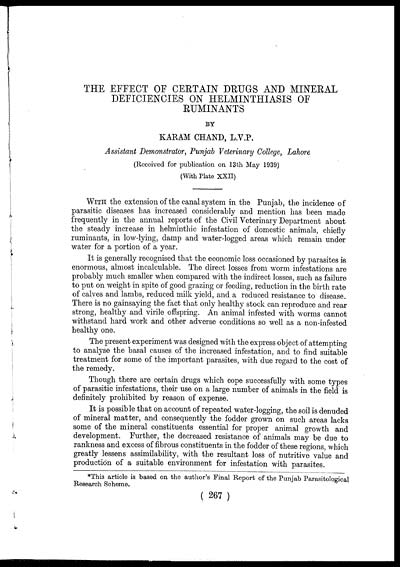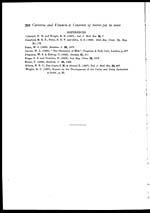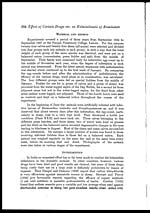Medicine - Veterinary > Veterinary colleges and laboratories > Indian journal of veterinary science and animal husbandry > Volume 9, 1939 > Original articles > Effects of certain drugs and mineral deficiencies on helminthiasis of ruminants
(167) Page 267
Download files
Individual page:
Thumbnail gallery: Grid view | List view

THE EFFECT OF CERTAIN DRUGS AND MINERAL
DEFICIENCIES ON HELMINTHIASIS OF
RUMINANTS
BY
KARAM CHAND, L.V.P.
Assistant Demonstrator, Punjab Veterinary College, Lahore
(Received for publication on 13th May 1939)
(With Plate XXII)
WITH the extension of the canal system in the Punjab, the incidence of
parasitic diseases has increased considerably and mention has been made
frequently in the annual reports of the Civil Veterinary Department about
the steady increase in helminthic infestation of domestic animals, chiefly
ruminants, in low-lying, damp and water-logged areas which remain under
water for a portion of a year.
It is generally recognised that the economic loss occasioned by parasites is
enormous, almost incalculable. The direct losses from worm infestations are
probably much smaller when compared with the indirect losses, such as failure
to put on weight in spite of good grazing or feeding, reduction in the birth rate
of calves and lambs, reduced milk yield, and a reduced resistance to disease.
There is no gainsaying the fact that only healthy stock can reproduce and rear
strong, healthy and virile offspring. An animal infested with worms cannot
withstand hard work and other adverse conditions so well as a non-infested
healthy one.
The present experiment was designed with the express object of attempting
to analyse the basal causes of the increased infestation, and to find suitable
treatment for some of the important parasites, with due regard to the cost of
the remedy.
Though there are certain drugs which cope successfully with some types
of parasitic infestations, their use on a large number of animals in the field is
definitely prohibited by reason of expense.
It is possible that on account of repeated water-logging, the soil is denuded
of mineral matter, and consequently the fodder grown on such areas lacks
some of the mineral constituents essential for proper animal growth and
development. Further, the decreased resistance of animals may be due to
rankness and excess of fibrous constituents in the fodder of these regions, which
greatly lessens assimilability, with the resultant loss of nutritive value and
production of a suitable environment for infestation with parasites.
*This article is based on the author's Final Report of the Punjab Parasitological
Research Scheme.
(267)
Set display mode to: Large image | Zoom image | Transcription
Images and transcriptions on this page, including medium image downloads, may be used under the Creative Commons Attribution 4.0 International Licence unless otherwise stated. ![]()
| Permanent URL | https://digital.nls.uk/75246937 |
|---|
| Description | Covers articles from 1939. Please note that pagination starts at p.139 and plates at Plate V. |
|---|




